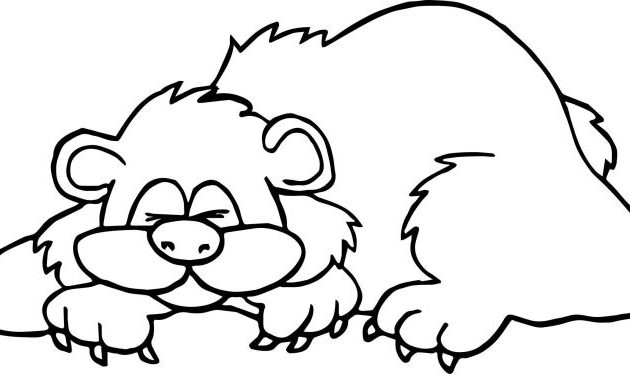Illustrative Descriptions of Hibernating Animals

Free coloring pictures of hibernating animals – Prepare to delve into the fascinating world of hibernation, where animals transform themselves to survive the harsh winter months. We’ll explore the physical adaptations and postures of three hibernators: the brown bear, the hedgehog, and the bat. These descriptions will paint a vivid picture for you, suitable for accompanying captivating illustrations.
Brown Bear in Hibernation
A massive brown bear, its fur thick and matted, lies curled in a den, a picture of slumbering strength. Its powerful limbs are tucked beneath its body, paws folded neatly. The bear’s head rests on its forepaws, its muzzle slightly pointed downward. Its breathing is slow and shallow, almost imperceptible. The overall impression is one of deep, peaceful repose, a stark contrast to its usual powerful presence.
Key visual elements for illustration: A deep, dark den; a large, bulky brown bear with thick fur; a curled posture with limbs tucked in; a relaxed facial expression; subtle shading to emphasize the deep sleep.
Hedgehog in Hibernation
A tiny hedgehog, a ball of prickly quills, is nestled within a leaf-strewn nest. Its body is tightly curled into a ball, its spines forming a protective shield. Its tiny paws are tucked close, and its head is almost completely hidden within the prickly armor. The overall appearance is one of vulnerability yet remarkable self-protection, a tiny warrior resting within its earthy fortress.
Key visual elements for illustration: A small, round hedgehog; densely packed spines; a curled-up, ball-like posture; a leaf-litter nest; muted earth tones in the color palette.
Bat in Hibernation, Free coloring pictures of hibernating animals
A small bat, its leathery wings folded neatly against its body, hangs upside down from the ceiling of a dark cave. Its tiny body is almost motionless, its head tucked slightly towards its chest. The bat appears fragile and delicate, a testament to the remarkable adaptation that allows it to survive the long winter months suspended in the air.
Key visual elements for illustration: A dark cave or crevice; a small bat with dark, leathery wings; a hanging, upside-down posture; wings tightly folded; a calm, almost imperceptible expression; subtle textures to show the leathery wings.
Educational Content Integration: Free Coloring Pictures Of Hibernating Animals

Embark on a fascinating journey into the world of hibernation with these insightful facts about our slumbering animal friends. Understanding the “why,” “how,” and “what ifs” of hibernation brings these captivating creatures to life, enriching the coloring experience and fostering a deeper appreciation for the natural world.
- Reasons for Hibernation: Hibernation isn’t simply a long nap; it’s a survival strategy employed by many animals, primarily to cope with harsh winter conditions. When food becomes scarce and temperatures plummet, hibernation allows animals to significantly reduce their metabolic rate, conserving energy and resources. This state of dormancy enables them to survive periods when foraging for food would be impossible or incredibly energy-intensive.
Think of it as nature’s built-in energy-saving mode, crucial for animals like groundhogs and bears.
- Preparation for Hibernation: Before embarking on their lengthy slumber, hibernating animals meticulously prepare. This preparation involves a period of intense feeding, allowing them to build up substantial fat reserves. This stored fat acts as their primary energy source throughout the hibernation period. They also might engage in behaviors such as finding a suitable den or burrow, providing insulation against the cold and protection from predators.
The woodchuck, for example, meticulously constructs its burrow, ensuring it’s well-insulated and safe.
- Dangers Faced During Hibernation: While hibernation is a remarkable adaptation, it’s not without its risks. Animals face threats such as predation, disease, and disturbances to their hibernation sites. A sudden drop in temperature, for instance, could deplete their fat reserves prematurely, leading to starvation. Similarly, predators might exploit the vulnerability of hibernating animals, posing a significant threat. For example, a badger might raid a groundhog’s den, disrupting its hibernation and potentially causing its death.
Coloring Book Page Design Integration
The educational content can be seamlessly integrated into a coloring book page design. For example, a page featuring a hibernating woodchuck could include a labeled illustration of its burrow, highlighting features like insulation and escape tunnels. A small inset could provide a simple diagram showing the woodchuck’s fat reserves, explaining their role in hibernation. Accompanying text could briefly explain the reasons for hibernation, the preparation involved, and the dangers the woodchuck faces during its winter sleep.
This multi-faceted approach transforms a simple coloring activity into a learning experience, making the information more engaging and memorable for young learners. The page could even include a small section with simple fill-in-the-blanks questions about hibernation, reinforcing learning in a fun way. For instance, a question like “Woodchucks store _____________ to survive the winter” could encourage active participation and knowledge retention.
Unleash your inner artist with our adorable free coloring pictures of hibernating animals! From sleepy bears to cozy hedgehogs, there’s a world of winter wonder to color. And if you’re feeling adventurous, why not expand your horizons with some vibrant coloring sheets asia animals , showcasing the incredible wildlife of the continent? Then, return to the peaceful charm of those hibernating cuties and complete your artistic journey.

